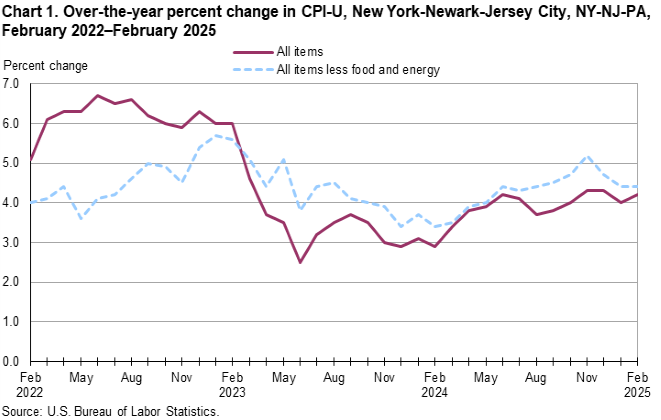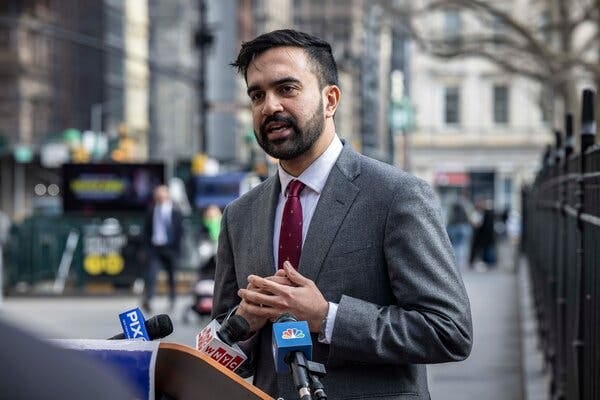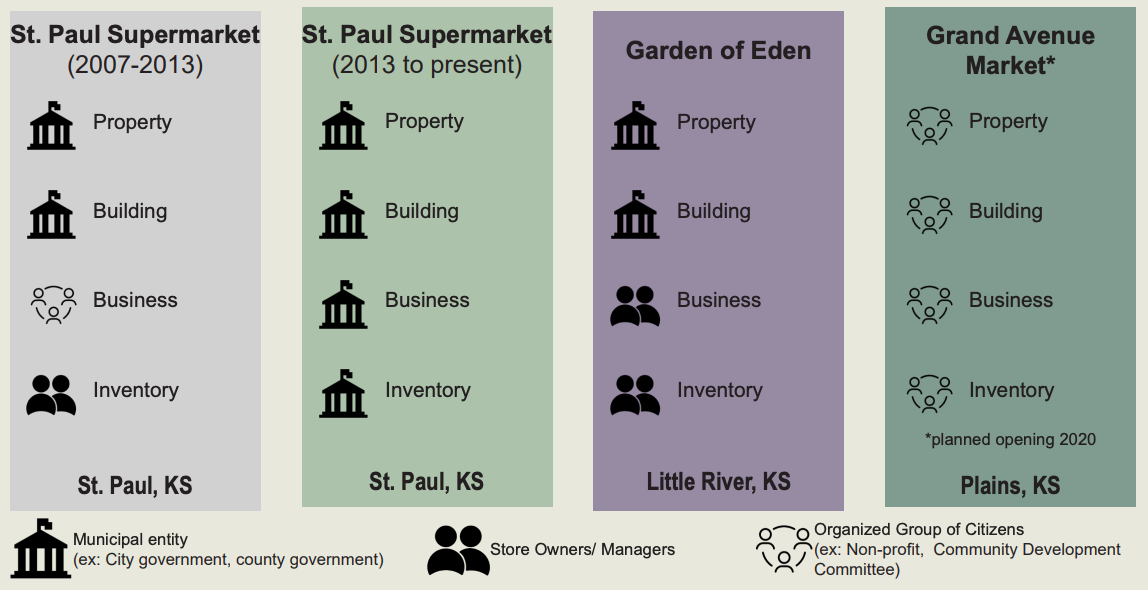UNLOCKED🔓 — Zohran Mamdani Wants NYC to Own Grocery Stores. Here's Why He's Right.
The market failed. Time for collective action.
Socialism tends to focus on big ideas. The Party for Socialism & Liberation’s presidential campaign pledged to nationalize America’s hundred largest companies, and the Democratic Socialists of America have long called for overhauling the medical system toward universal coverage. I agree with these projects, but I also don’t believe every leftist policy needs to be gargantuan. One of the best ways to court support for progressivism is to show the public how collective solutions can assuage the frustrations of daily life. That’s why I’m ecstatic about Zohran Mamdani’s proposal to open government-run grocery stores in New York City.
One of ten candidates in NYC’s mayoral race, Mamdani is currently polling second behind Andrew “I’m not perverted, just Italian” Cuomo.1 Like the rest of the country, NYC suffered food inflation during the post-COVID years, contributing to a rising cost of living. In February, The Bureau of Labor Statistics reported that food prices in the New York/New Jersey area rose by 2.7% in the last year alone.2 Naturally, addressing the high price of food, rent, and energy is a top issue for candidates.
What little information Cuomo has published about his plan to decrease food costs is wanting. I found a PDF buried in his website that restates what he did as New York’s Governor (promote farmers’ markets, leverage food banks) and promises an “ambitious approach aimed at increasing access to healthy food.”3 The lack of specifics is only outdone by the lack of charisma.
Alternatively, Mamdani’s proposals have been clear and persuasive. In addition to rent control and free bus fare, the democratic socialist wants to put a city-owned grocery store in each borough to provide food at as low a cost as possible. From his campaign website:
[City-owned grocery stores] will buy and sell at wholesale prices, centralize warehousing and distribution, and partner with local neighborhoods on products and sourcing. With New York City already spending millions of dollars to subsidize private grocery store operators (which are not even required to take SNAP/WIC!), we should redirect public money to a real public option.
Publicly owned grocery stores are essentially a streamlining of the subsidized private grocery stores Mamdani speaks about. Instead of giving taxpayer dollars to a middleman, they would go directly to distributing food. Since 2009, the city has given tax breaks and subsidies totaling $100 million to private grocery stores in food deserts and impoverished neighborhoods through its Food Retail Expansion Program to Support Health program (FRESH).4 As the above text mentions, these stores are not required to take welfare, undercutting their supposed purpose to help low-income families. A 2015 study found no conclusive evidence that these subsidies improved food availability, so clearly, there’s room for improvement.
The introduction of a government-subsidized supermarket into an underserved neighborhood in the Bronx did not result in significant changes in household food availability or children’s dietary intake. — Assessment of a government-subsidized supermarket in a high-need area on household food availability and children’s dietary intakes5
That study is a decade old, so new evidence is warranted. However, the last half-decade has seen food prices rise, so I’m confident the program lacking in 2015 will remain insufficient in 2025. As you’re probably aware, large grocery chains took advantage of COVID-era inflation to further increase prices (a phenomenon aptly named “greedflation”) and purchased supply chain manufacturers to consolidate their market power. A 2024 Federal Trade Commission report stated that food and beverage retailers made larger profit margins during COVID (7% in 2023) than their pre-pandemic peaks (5.6% in 2015).6 Mamdani’s solution to this problem is simple: remove the profit motive from the food distribution process.
By buying food at wholesale prices and selling it at cost, New Yorkers can avoid paying the profit premium capitalist companies require. In 2024, the three largest food providers in America profited approximately $27.9 billion: Walmart: $14.8 billion7; Costco: $9.28 billion8; and Kroger: $3.8 billion910. A public grocery, uninterested in charging customers extra to create these billions for shareholders, cuts out that layer of fat. Shoppers pay what it costs to get the food onto their kitchen tables, seldom a cent more.
Mamdani aims to put one public grocery in each of New York’s five boroughs, but even those who won’t live near these locations will reap their benefit. As these stores will be public options in a market of private actors, they’ll put downward price pressure on the existing capitalist competitors. With the government’s low-cost option attracting customers, stores like Kroger and Walmart will be forced to lower prices to compete. It would also drive them to raise wages and improve working conditions to keep employees from migrating to stable jobs working for the city. The effect of public option competitors has been well-researched in the context of medical care.11 When Joe Biden quickly abandoned his campaign promise of a public option in the first months of his presidency, top Democrats urged him to reprioritize it to, among other things, “lower healthcare costs for American families.”12 I’ve written about the need for a public airliner to improve the quality of American air travel, a practice used in New Zealand, China, and many other nations. Anyone who has shipped a package with FedEx or UPS has felt the impact of the public option USPS stopping package carriers from charging exorbitant prices.

This program also has the benefit of proven examples to build off of. As the 21st-century has seen small rural towns shrink, collectively owned grocery stores have been the mechanism to keep rural Americans fed. A 2020 study found that in cities with under 2,500 people, grocery stores’ average profit was 1.1%. Teetering on the edge, a rise in inflation, or an exodus of residents could condemn these businesses to bankruptcy and leave the town hungry. Recognizing this, St. Paul, Kansas, decided it needed a food supplier in 2004. The city built a store and asked a private retailer to run it. They did, but in 2013, St. Paul decided to own the store altogether. It has functioned as a publicly-owned grocery store ever since.13
Mambani has also pointed to Erie Market in Erie, Kansas, as proof the public model can work. When the town of a thousand people heard its only supermarket was closing, 68.5% of survey respondents encouraged the local government to buy it. They did, and Eire Market kept the quant prairie town alive.14 While Eire is an excellent example of how a socialist policy can remedy the failings of a capitalist market, the small town’s woes have been the basis for critics of Mumbani’s proposal. One such criticism was recently published in City Journal:
The Erie Market in tiny, remote Erie, Kansas, is the most cited example of this [public grocery store] experiment. The store loses tens of thousands of dollars annually, requires volunteers to stock the shelves, and relies on donations of produce from local businesses."
I can never tell if conservatives critique social programs in extraordinarily bad faith or if they cannot fathom the purpose of a profitless enterprise. Like the post office, public grocery stores do not “lose money.” They cost money to operate. The purpose of a state-owned enterprise (SOE) intending to fulfill a societal need (as opposed to one designed to maximize revenue, such as Alaska’s oil fund) is to do just that: provide a good for whatever it costs to do so. Critiquing them as “losing money” is as silly as claiming buying a car is a bad decision because it costs money, while ignoring the benefit of transportation.
Like countless small towns across America, the private market failed New Yorkers. It’s difficult to even get food in large swaths of the city (primarily impoverished and minority neighborhoods), and the current neoliberal program of subsidizing private corporations has failed to satisfy these areas. On top of that, New Yorkers are like all Americans in that they are forced to pay the high prices created by parasitic capitalists. The “free” market solution was tried, as was the public-private partnership model. They both failed.
What Zohran Mamdani is suggesting is the obvious next step for a city trying to feed its residents. There’s been a lot of talk from the liberal Democrat class about the need for an abundance of necessities in blue states and cities. Well, here’s the best way to make food abundant and available in the largest city in America. I hope Zohran Mamdani can count on your support in his race against disgraced sex-pest Andrew Cuomo.
If you like this article click the ❤️ and subscribe to receive new essays straight in your inbox. Thanks!
In Solidarity — Joe
https://www.dataforprogress.org/blog/2025/3/26/cuomo-leads-nyc-mayors-race-with-39-mamdani-at-15-all-other-candidates-in-single-digits
https://www.bls.gov/regions/northeast/news-release/consumerpriceindex_newyork.htm
https://www.andrewcuomo.com/sites/default/files/documents/affordability-plan.pdf
https://edc.nyc/program/food-retail-expansion-support-health-fresh
https://pmc.ncbi.nlm.nih.gov/articles/PMC10271373/
https://www.ftc.gov/news-events/news/press-releases/2024/03/ftc-releases-report-grocery-supply-chain-disruptions
https://www.spocket.co/statistics/walmart-earning-and-revenue.
https://www.statista.com/statistics/1529302/costco-wholesale-operating-profit/
Kroger’s $3.8B is the operating profit, so this figure doesn’t include interest payments and taxes.
https://www.tradingview.com/news/tradingview:3f04658ce3312:0-kroger-reports-fourth-quarter-and-full-year-2024-results/
https://www.brookings.edu/articles/capping-prices-or-creating-a-public-option-how-would-they-change-what-we-pay-for-health-care/
https://www.help.senate.gov/imo/media/doc/Public%20Option.2021.5.26.Letter%20for%20General%20Public.pdf
https://www.ruralgrocery.org/learn/publications/case-studies/St_Paul_Success_Story.pdf
https://thehustle.co/the-small-town-that-saved-its-only-grocery-store-by-buying-it






Public options are great because without the profit nonsense, they can undercut the capitalists and slowly drive them out of the market completely. Even when I was still a Republican back in my younger days, I knew that having a public healthcare option in Obamacare would drive private insurers out of business because they wouldn't be able to compete. I was against it for that reason back then. It annoys me that, even with that painfully obvious indicator that capitalism is wildly inefficient, it still took me another decade or so to escape the ignorance of conservatism. And I went through right wing libertarianism to get there :-p Hindsight I guess
Moronic take. Kroger sold $150 billion foods for a paltry 2.5% profit.